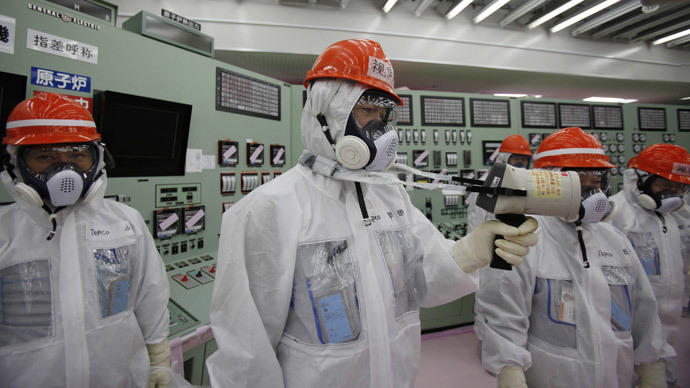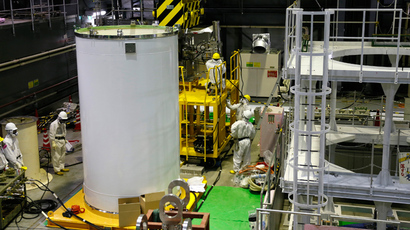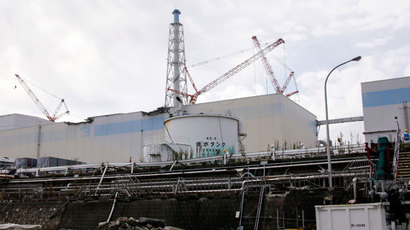3 years on: Contaminated Fukushima water may be dumped as problems mount

Contaminated water at the battered Fukushima plant has taken precedence over everything else. As the larger cleanup effort continues and storage space for the water is rapidly running out, scientists suggest dumping it into the Pacific Ocean.
The plant’s chief, Akira Ono, has testified to the seriousness of the situation during a Monday visit by international media, saying that “the most pressing issue for us is the contaminated water, rather than decommissioning. Unless we resolve the problem, fear of the community continues and the evacuees cannot return home,” the AP cited him as saying.
The massive amount used to cool the melted cores of three reactors has been wreaking havoc with onsite radiation, which also began to seep into the ground a while back, with TEPCO having tried different techniques for stalling or containing it. But it has repeatedly been finding its way into the Pacific as well.
Four hundred and thirty-six tons of contaminated water is stored in 1,200 tanks suspended above ground all over the site. TEPCO has made progress with water treatment units to filter out strontium and cesium from the water and make it safer for storage.
They say the remaining tritium is much safer to dump into the ocean later.
A plan to build an underground frozen wall around the four damaged reactors has been in the works for a while, but experts insist this this measure, worth billions in government funding, is as temporary as othersothers have been. Although similar routes have been taken at American sites in the past, something of the sort on this scale has never been attempted.
On Monday, TEPCO was setting the wall up for a test run at another location at the site. The final version will be a 2km thick wall around all four damaged reactors. The test run starts in four days, while the final version isn’t due until next year.

That deadline is not set by TEPCO; it’s when the plant will eventually run out of storage capacity, whether it’s ready or not.
The former chairman of the US Nuclear Regulatory Commission, who now heads a group of external decommissioning advisers, Dale Klein, believes “storing the massive amounts of water in tanks is not sustainable… it’s not science that needs to be developed, but it’s public policy.” Klein is known to be a vocal opponent of the frozen wall approach.
This is also important because extensive leakage and increasing amounts of radioactivity put cleanup workers in increasing danger. The 5 milisievert exposure benchmark that, when crossed, qualifies the worker for compensation on health grounds, has fallen from 2,900 claims in 2011 to just 98 in June of 2013; however, it was four times that by October. Keeping the place continually manned is not easy because some workers have had it so bad they can’t risk ever working at the plant again.
In the midst of this is the cleanup operation, seeking to develop new robotic technology to expedite the process and removing melted fuel from the damaged reactors by 2020 – itself a multi-billion dollar venture whose deadline is too optimistic, some experts say.
Between the lines
But one problem that may get left out of the topic is the fallout on the local population. Life has literally stopped to such an extent that subsistence in areas around the prefecture will not return to normal for decades; while a whole generation of small children in Koriyama, a short drive from the plant, are growing up literally without being able to go outdoors, Reuters reported.
And the nuclear hazard warnings aren’t effective either, with health effects very noticeable.
Three years since the worst atomic incident after Chernobyl (1986), children are growing up with half their normal strength, dulled senses, weakened immune systems, and sometimes, even blindness, according to officials and educators. Add to this the psychological problems associated with the current lifestyle.
"There are children who are very fearful. They ask before they eat anything, 'does this have radiation in it?' and we have to tell them it's OK to eat," Mitsuhiro Hiraguri, director of the Emporium Kindergarten in Kiriyama told Reuters. The facility is some 55km from the Fukushima Daiichi plant.
"But some really, really want to play outside. They say they want to play in the sandbox and make mud pies. We have to tell them ‘No, I'm sorry. Play in the sandbox inside instead,’” Hiraguri continued.
Children’s outside play time has been limited to 15 minutes a day. “Try to avoid touching the outside air,” one local mother was overheard telling her child.
The one glimmer of hope is the experts’ prediction that these children will not develop thyroid cancer, the way many did with Chernobyl levels of radiation. But this doesn’t change the fact that for this generation, some things in life will have irreversibly changed – both physically and mentally.
The earthquake of March 2011 in the Miyagi prefecture measured a staggering magnitude 9 on the Richter scale, causing a series of tsunamis that spawned deadly, 20-30-meter waves and claimed 16,000 lives, making a further 2,600 disappear without a trace. In the ensuing reactor meltdown, the lives of 267,000 Japanese were changed forever. To this day, they are displaced and living in temporary government shelters, while for their children the post-meltdown life is the only kind they have ever known.

The one glimmer of hope is the experts’ prediction that these children will not develop thyroid cancer, the way many did with Chernobyl levels of radiation. But this doesn’t change the fact that for this generation, some things in life will have irreversibly changed – both physically and mentally.
The earthquake of March 2011 in the Miyagi prefecture measured a staggering magnitude 9 on the Richter scale, causing a series of tsunamis that spawned deadly, 20-30-meter waves and claimed 16,000 lives, making a further 2,600 disappear without a trace. In the ensuing reactor meltdown, the lives of 267,000 Japanese were changed forever. To this day, they are displaced and living in temporary government shelters, while for their children the post-meltdown life is the only kind they have ever known.














